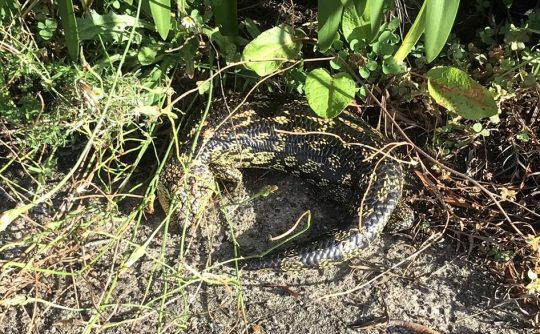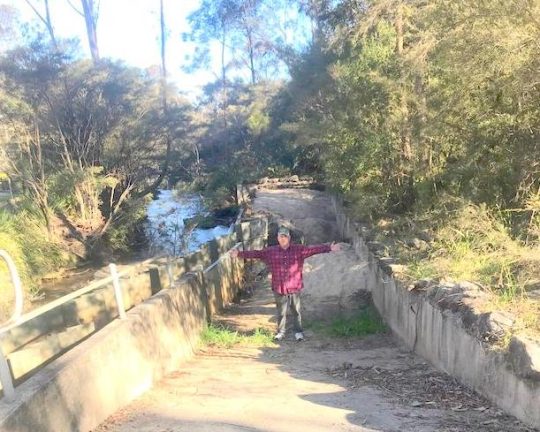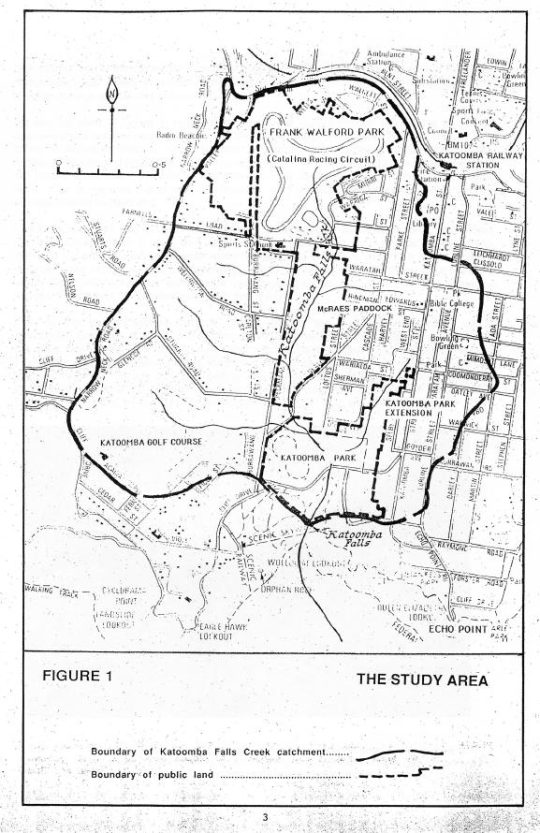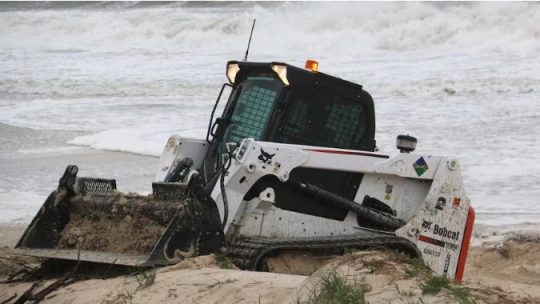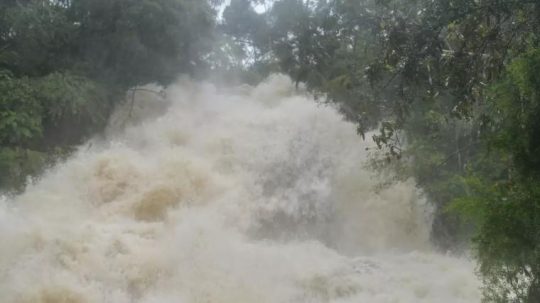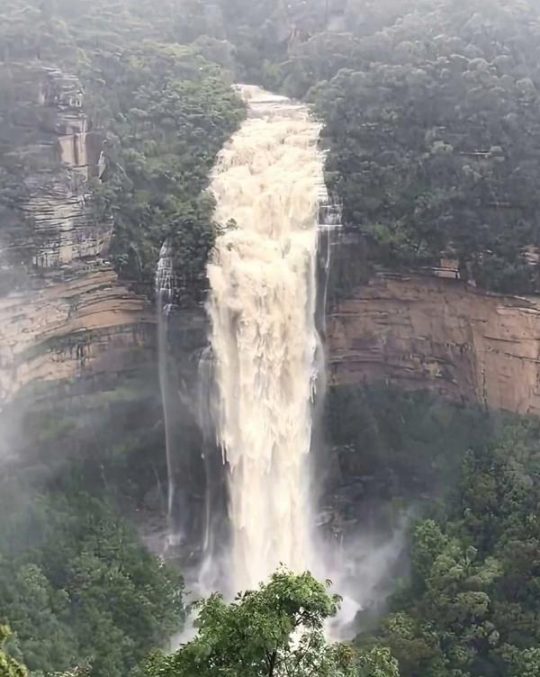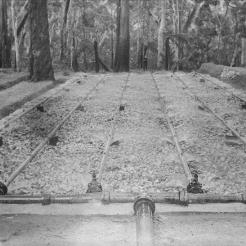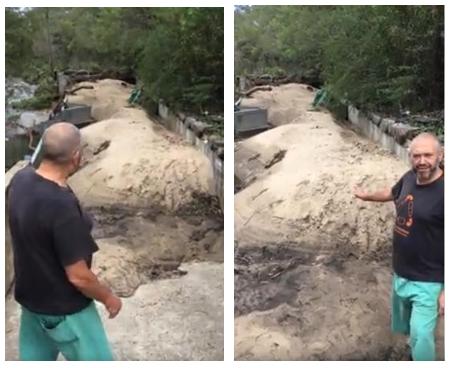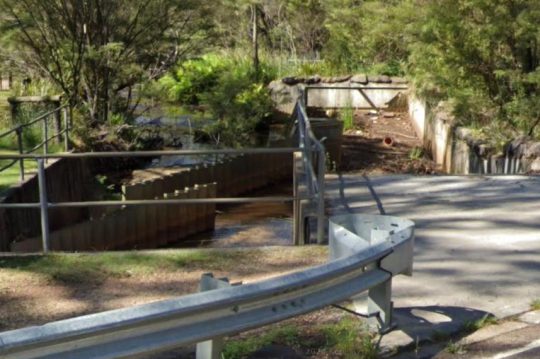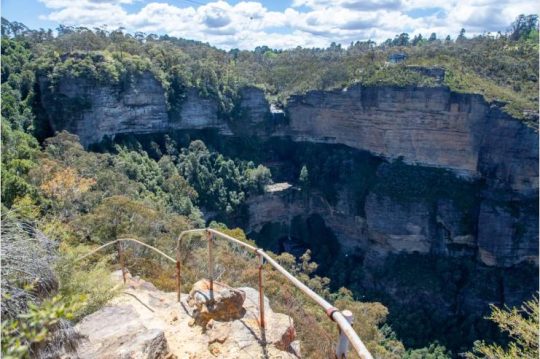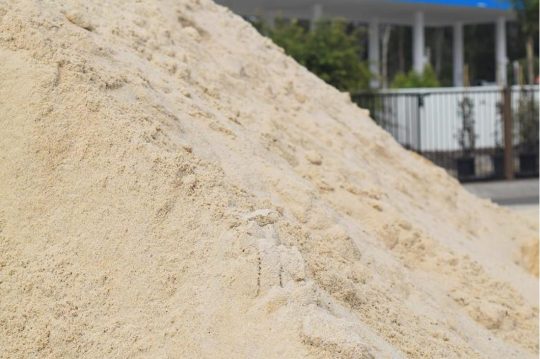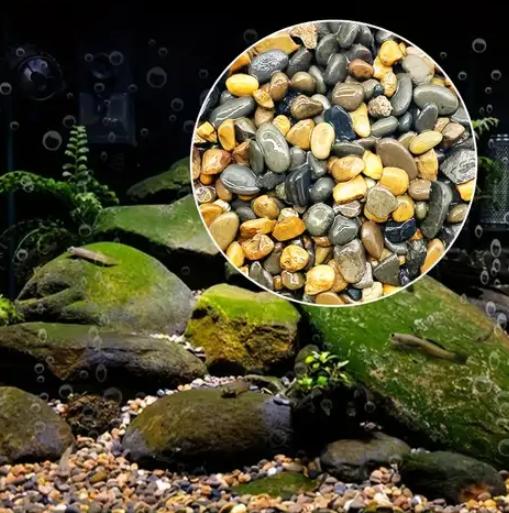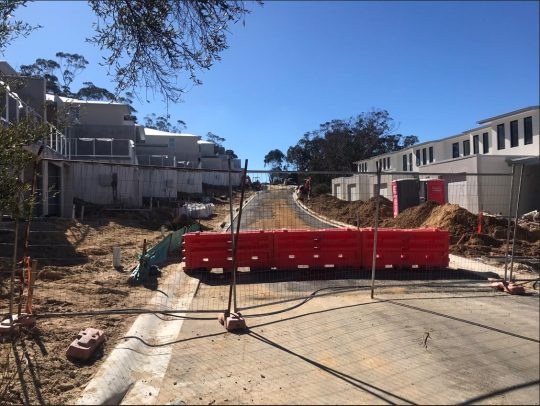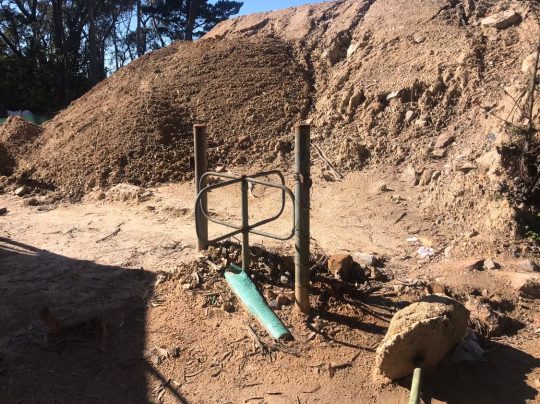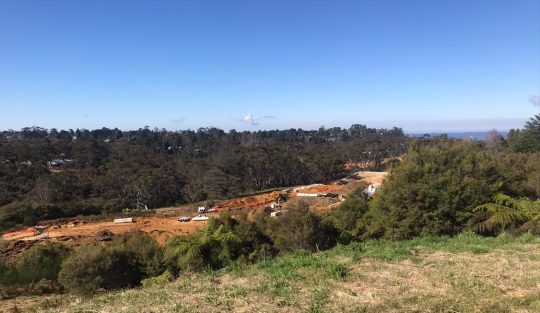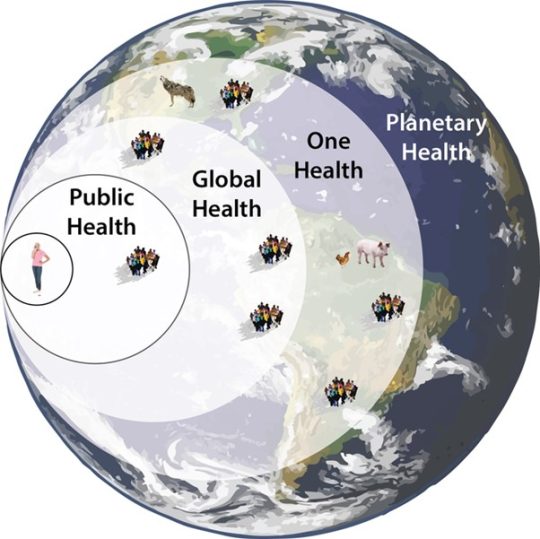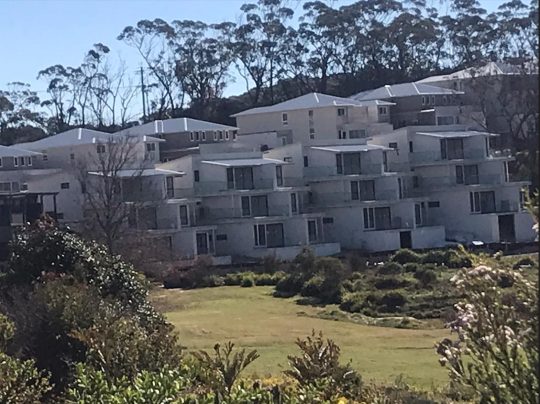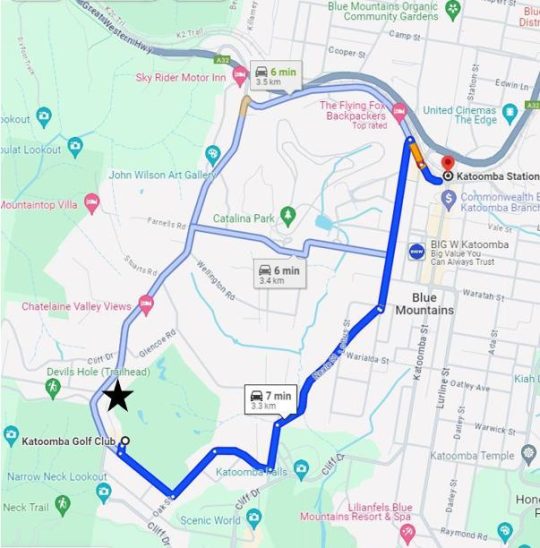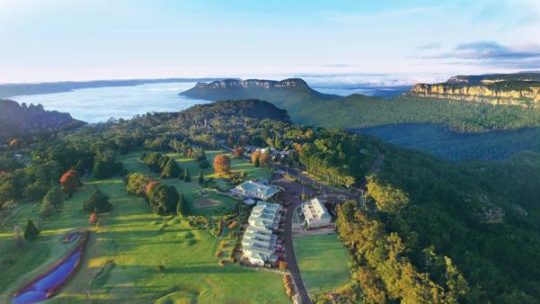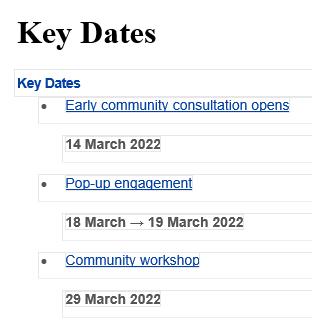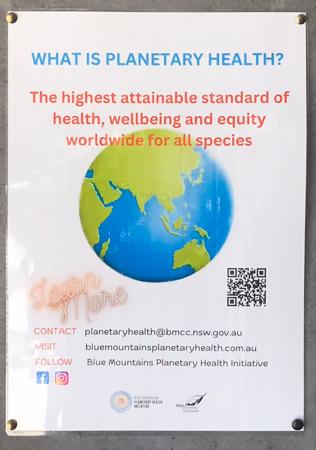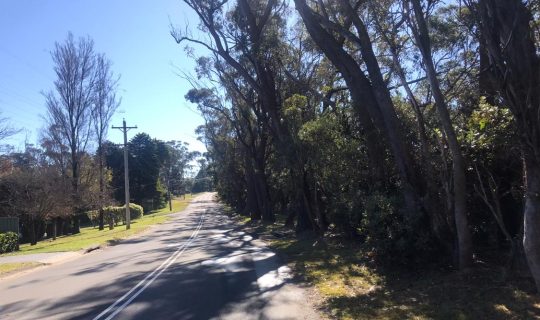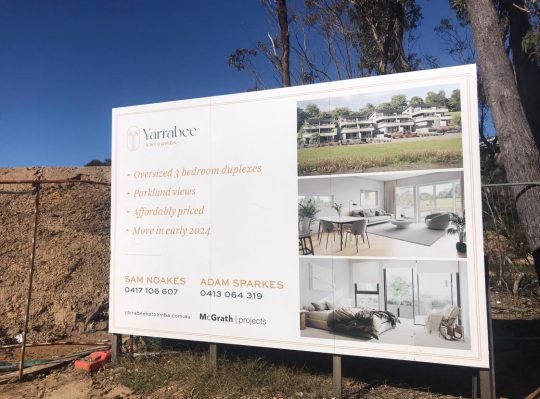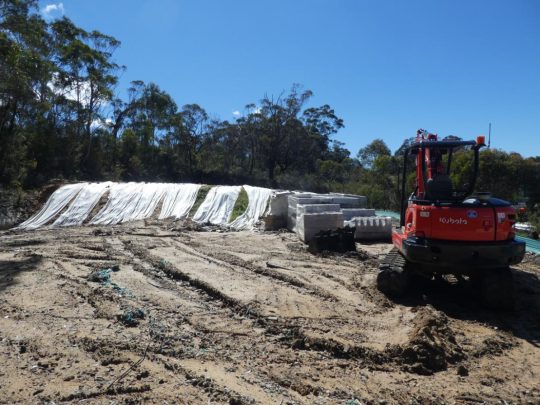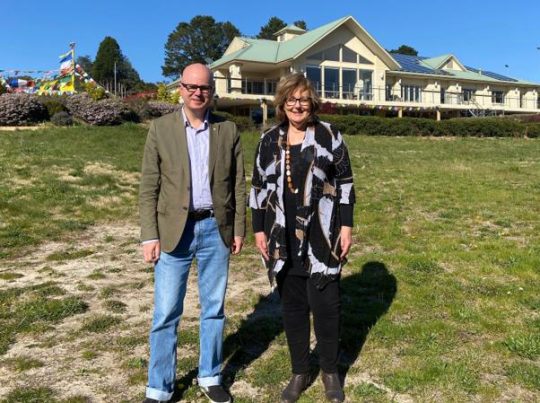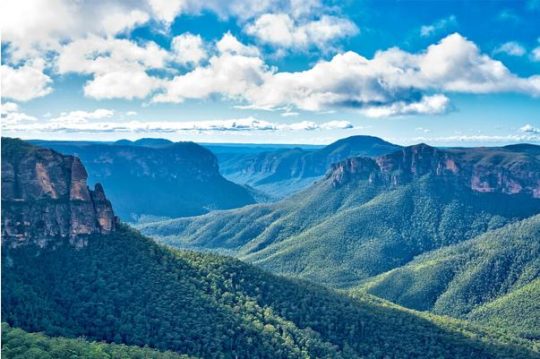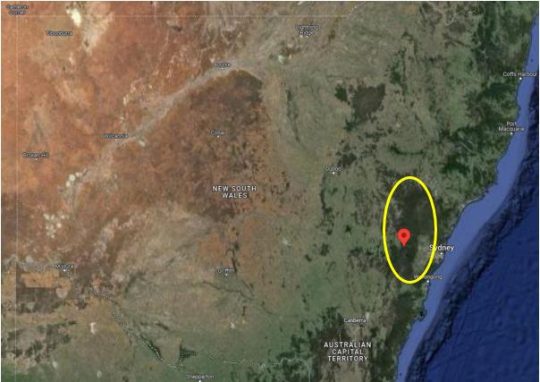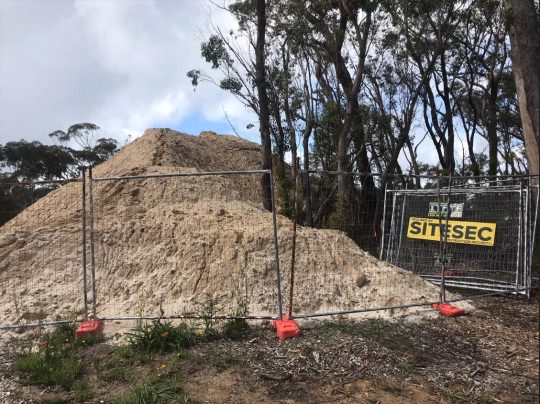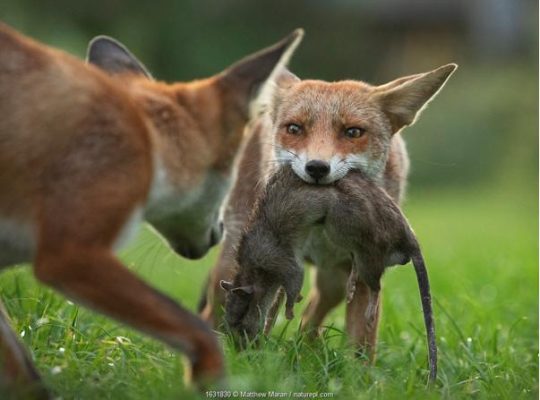Blue Mountains native nursery eviction threat…
by Steven Ridd
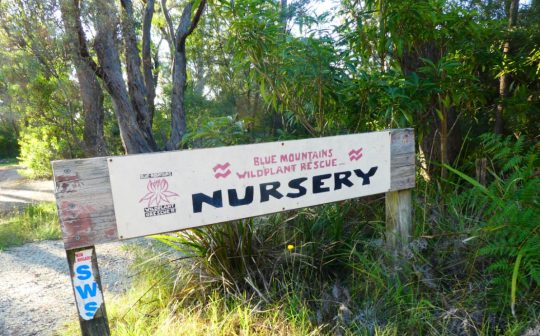
…somewhere backing Australia’s World Heritage ecological values…
The Habitat Advocate has sadly learned about a governmental threat to evict this much loved and valued local community volunteer-run nursery business in Katoomba in the Australian Blue Mountains region, successfully operating onsite since 1999.
This author learned about this from off the grapevine, else we should have otherwise learned about this news development from reading our local Blue Mountains Gazette newspaper. Yet, that valued weekly newspaper informing locals about Blue Mountains goings-on has been denied us for some years. The paper has not been distributed to our Katoomba Falls Creek residential precinct since long before COVID – like for the past 5 years or so!
An unviable newspaper business model for these times? One notes that the newspaper’s distribution statistics have been removed from this newspaper’s print masthead for some time (Read a harbinger of the Gazette’s pending closure)

Moving on… a few weeks back a Blue Mountains friend informed us about this news of the nursery, then kindly dropped around his copy of the Gazette issue dated Wednesday 15th January 2025.
This is the front page article with the legendary Blue Mountains Wildplant Rescue Service (‘Wildplant Rescue’) on the front page we read:
‘Eviction day looms for Wildplant Rescue nursery’
15th January 2025, by Jennie Curtin, BMG journalist)

[SOURCE: Blue Mountains Gazette (BMG) newspaper, Page 1, Wednesday 15th January 2015. Photo by Jennie Curtin]
‘Time is running out for the Wildplant Rescue nursery at Katoomba.
The volunteers have been told they have until the end of April to find a new home, after the owner, the NSW Department of Communities and Justice (DCJ), cited maintenance costs and fire safety issues. (Author: aka the landlord’s wanton neglect of this bushland site for decades, and a rubbish slack ulterior motive excuse to flog off the site for profit to a developer for housing – truth telling!)
The department wants to sell the site, which used to be adjoined to the now-closed and re-purposed Clairvaux Children’s Home adjacent and which is in need of repair, restoration and safety features.
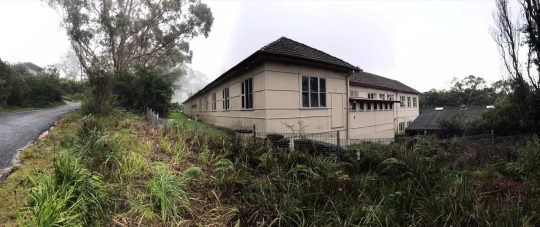
The NSW Government department’s old notorious ‘Clairvaux Childrens Home’ (1969-1990) situated at adjacent 41 Violet Street Katoomba. It became a ‘home of horrors’ for violated young boys. It was eventually shut down in criminal disgrace. Since the 1990s it has been ‘occupied’ by the Katoomba Christian Convention (KCC). God knows why – It’s a place of Evil. [Recent photo by author]
The entire Clairvaux Community Services site has long been neglected by the NSW Government for decades. Dozens of abandoned and vandalised buildings by ACRC snuggled in nativve bushland, now warrant demolition. They contain asbestos interior fabrication wall lining from the 1970s.
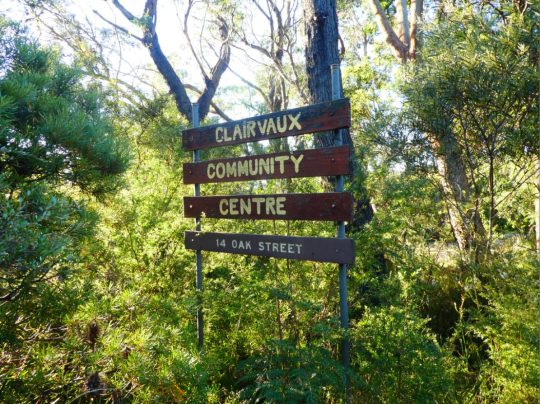
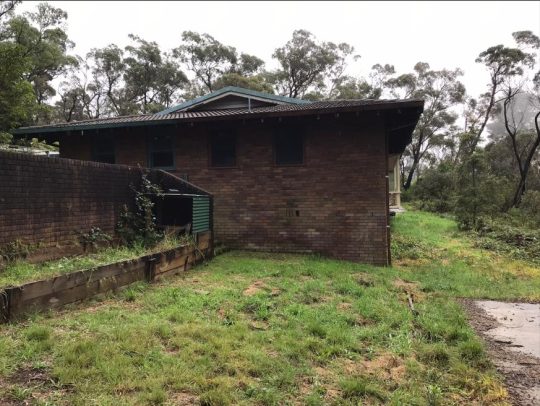
Adjacent to Wildplant Rescue’s pro-bono tenancy is this other unrelated tenant of DCJ’s Calirvaux Community Centre site. The photos shows one of dozens of outbuildings situated on the DCJ’s Clairvaux Community Services’ 8 hectare bush site in outer Katoomba – but long vacated, (evicted by DJC?) so since abandoned, left derelict and since vandalised. [Recent photo by author]
The cost of setting up elsewhere is beyond the means of the volunteer-run nursery, which rescues local native species from building sites and propagates them as well as other rare and difficult natives. It sells the plants to home gardeners as well as council, landscapers and Bushcare organisations, providing the income to keep going.
The volunteers are desperately hoping the department changes its mind and gives them a permanent lease on their small section of the site. The only alternative, said president Verity Harris, is to find a benefactor with deep pockets. “If there’s a good millionaire out there with a plot of land …” she said hopefully.
The group had talks with council about a possible site during the planning of the old Katoomba golf course precinct. But a spokeswoman for council said “a plant nursery is not a permissible use on this site under the current zoning, and an amendment to the LEP would be required to include this and other additional uses. That would be a lengthy process including making a submission to the state government and further public consultation.”
The DCJ said it recognised the important service the nursery provides in protecting threatened species but a land condition audit of the site in 2020 found that it was not fit for purpose and was not safe for long-term use because of its fire zone.
DCJ:
“Tenants of the site were notified of the need to vacate the site in 2021 and since then almost all have relocated. DCJ has not provided formal notification to the nursery to leave the site whilst we continue to assist them to find a new home.”
The nursery has operated at the site since 1998. Although it receives no funding, Ms Harris acknowledged that DCJ did not charge them for rent or for water and electricity.
One of the difficulties with an unknown future is that no forward decisions can be made. The group recently spent money on new benches for the plants but don’t want to install them in case they have to take them down. There is also a greenhouse which is lying unassembled for the same reason. “The uncertainty is really quite crippling,” Ms Harris said. Volunteer Frances Scarano said the group only propagates native plants from the Mountains to ensure genetic purity. “We extend the diversity” of plants grown in Mountains gardens as well as giving wildlife more food and shelter sources,” she said.’
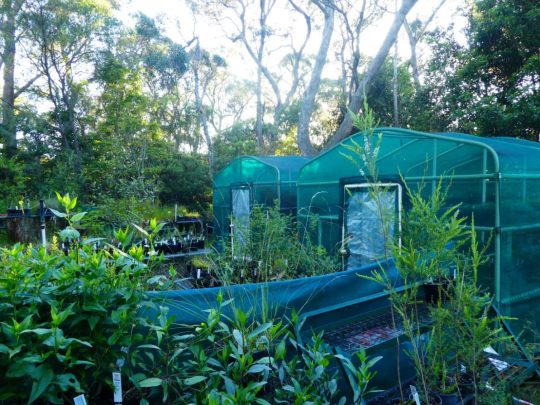
Blue Mountains Wildplant Rescue Service – a portion of its professional Native Plant Nursery, juxtaposed to native habitat surrounding the site. An ideal position. [Recent photo by author]
There’s a local Blue Mountains community story in this.
The above news item conveys more than a harbinger of pending closure; rather it tells publicly (about time, frankly) of an existential threat to the future of the Blue Mountains Wildplant Rescue Service (Wildplant Rescue) not just from its current site, but because it has nowhere else to go, from its very existence – termination of the whole not-for profit business, of its local volunteers and of its support base membership – the lot facing oblivion!
[NOTE: An “existential threat” refers to a danger that could lead to the complete destruction or a permanent and severe degradation of something. It’s a threat to the very being or future potential of something – aka Wildplant Rescue in this case.]
Wildplant Rescue continues to be a long-established successful not-for-profit local business very popular in Katoomba in the Blue Mountains of Australia and founded and run by its volunteers, and with a strong long-standing membership backing.
Wildplant Rescue photo gallery:
We reckon this eviction threat to Katoomba’s much loved native nursery is yet another example of the distant NSW Government’s bureaucratic insular mindset and its ongoing anti-social culture of destroying local small businesses for the greed of selling off public land (native bushland) that it controls on a entrusted custodial basis on behalf of the community. This eviction threat is bureaucracy selfishly seeking to profit from more bushland asset sales for inevitable housing development. It is not good government.
This closure threat to this unique endemic native plant nursery is unnecessary, unfair, contrary to the departmental landlord (DCJ’s) community focuses, and down right politically motivated by the incumbent NSW Minns Government bureaucracy and his politicians. The NSW Government’s eviction threat is wrong and unjustifiable. It’s threatened eviction of Wildplant Rescue is for non-genuine grounds. Yet hypocritically, the incumbent NSW Minns Labor Government publicly has stated:
“Landlords could be fined for making up a “non-genuine reason” for punting a tenant under NSW laws to scrap no-grounds evictions”.
[SOURCE: https://www.bluemountainsgazette.com.au/story/8709944/landlords-face-fines-for-non-genuine-eviction-reasons/ ]
This has been an election policy of Labor Chriss Minns before the NSW state election on 25th March 2023. Subsequently, as Premier, Minns is overseeing his own government department, DCJ as landlord using non-genuine reasons for punting Wildplant Rescue as tenant at the Clairvaux Community Centre site.
DCJ’s Eviction Threat Facts:
(from our research)
- Wildplant Rescue has been an active nursery business tenant at the site since 1998, so for a continuous 27 years;
- DCJ has/does not charge(d) Wildplant Rescue for rent, for water nor electricity. Yet this has been a mutual agreement between landlord DCJ and tenant – since DCJ has from the outset acknowledged that Wildplant Rescue is a local not-for-profit organisation providing a highly valued community service – rescuing Blue Mountains native plants from development sites, propagation local native plants (including threatened species) and participating in key roles in the local Blue Mountains bush regeneration industry. Further, DCJ has over the years seconded the community support of Wildplant Rescue to ’employ’ youth offenders under undergoing criminal rehabilitation within the community, and WildPlant has obliged (although its petty cash box went missing a few times – subsequent measures are that no cash it kept on premises such that so little of it ever was);
- DCJ for decades has chosen not to maintain its Clairvaux site in outer Katoomba. It is this systemic bureaucratic failure by DCJ which underlies how now the dilapidated state of the buildings across its owned Clairvaux property site in outer Katoomba has been continually neglected and allowed to deteriorate by DCJ. (See our recent ACRC photo gallery below);
- That DCJ’s outsourced site audit in 2020 reported that many buildings were not fit for purpose, remains wholly the responsibility of the DCJ as ongoing landlord for its systemic neglect of the buildings across the site. It is no way any fault of the long standing good tenant, Wildplant Rescue;
- The site is dominated by bushland, so it is in a bushfire zone, but then this is an ideal site for a native plant nursery – juxtaposed next to native bushland. It is not an appropriate site for social housing, which would necessitate many hectares of intact native bushland to be first bulldozed, and considerable environmental harm and cost to DCJ;
- DCJ’s eviction reasons to Wildplant Rescue are on spurious, non-genuine and unreasonable grounds. So much for Labor Chris Minns’ no grounds eviction ban election promise.
- On 24 October 2024 the NSW Parliament passed the (NSW) Residential Tenancies Amendment Bill 2024. The legislation is now the (NSW) Residential Tenancies Amendment Act 2024. Relevant to Wildplant Rescue’s tenancy eviction threat, despite it being a business tenancy and not a residential tenancy, we raise pertinent sections of this new (NSW) Residential Tenancies Amendment Act 2024. Why should not the same principles apply to a not-for-profit tenant? That analytical article is pending on this website. We thank readers for their patience. We believe that no other website of journalist is covering this details issue as we are. We seek the truth in such topics always.
Aboriginal Cultural and Resource Centre derelict – photo gallery:
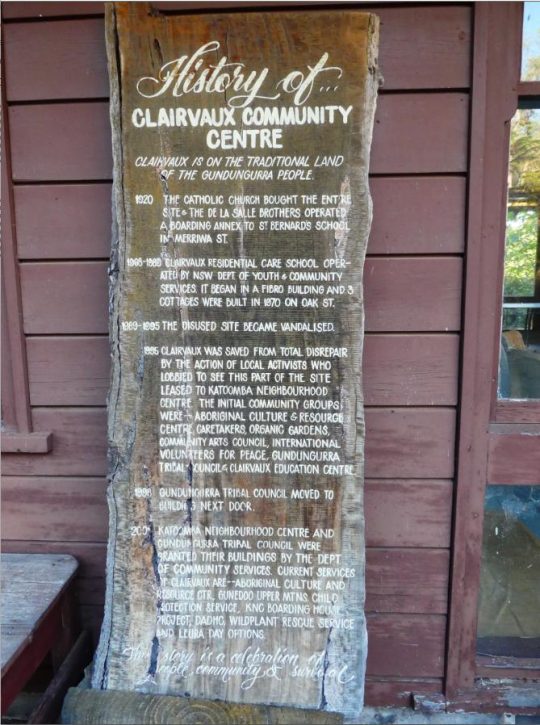
And who seriously, would turn on the ACRC’s private fire hydrant and leave it running for weeks…months to waste precious drinking water?
We took a video of this upon our visit to the DCJ’s Clairvaux Community Centre site on Sunday 30th March 2025.
DCJ’s eviction threat of Wildplant Rescue is a conjured bureaucratic notion for an impractical social housing estate white elephant in bushland some 2km outside Katoomba
It’s all a political ruse!
Wildplant Rescue’s nursery site occupies a very small parcel of rural bushland covering less than half a hectare. The nursery is situated on a western boundary off Oak Street Katoomba as part of the quite sizeable 8 hectare DCJ Clairvaux bushland site.
The Clairvaux site is geographically located within The Gully Water Catchment on the western edge of the regional township of Katoomba in the Blue Mountains region of Australia. The nursery site is within native Eucalypt bushland and is some distance from Katoomba’s high street, which is more than 2 km away and an uphill walk.
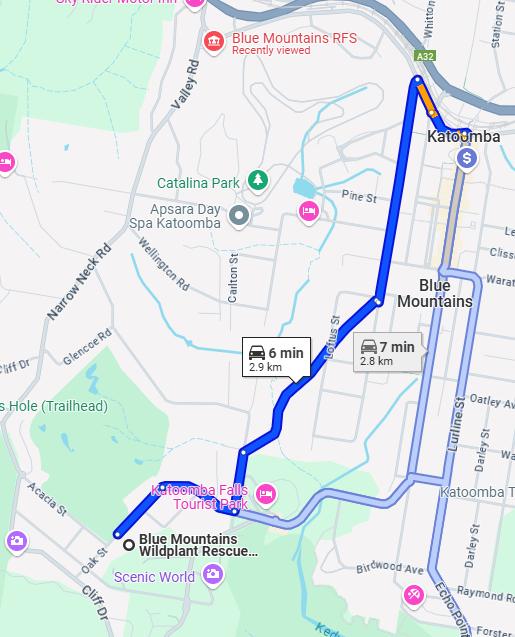
A location map of Wildplant Rescue relative from Katoomba township’s (high) Street – about a 3km uphill walk to Katoomba Train Station one- way. Wildplant Rescue lies within The Gully Water Catchment. [Source: Google Maps, recently]
So, the Clairvaux site location is not exactly convenient to shops nor amenities and the only public transport an hourly bus service into town along Oak Street. So the site suits being a place to propagate native plants, which is what Wildplant Rescue does and has been doing successfully on a shoestring budget consistently since 1999, so now twenty-six continuous years.
A recent walk around of Wildplant Rescue’s current site by this author:
Yet management has known about this eviction threat since before May 2020…
Let the truth be known – the founder of The Habitat Advocate and as Editor of this website, Steven Ridd, is a local of Katoomba in the Blue Mountains since 2001, so far, here for 24 years and going nowhere.
Consistent with the conservation tenets of The Habitat Advocate organisation, Steven had been a committed and active member of Wildplant Rescue on and off since 2009, having first initiating contact with committee member Alison Hatfield back in April 2008. Steven’s association included volunteering in various capacities and then joining the management committee. It was an on-and-off participation as work and family priorities permitted such volunteering contributions, as many juggle with.

The road to Wildplant Rescue…

Arriving at Wildplant Rescue’s unique, genuine nursery – plentiful with local endemic Upper Blue Mountains native plants…an emblematic not for profit charged to truthfully sustain planetary health by example [Recent photo by author].
Back on Thursday 26th February 2009, Steven attended his first meeting of Wildplant Rescue’s Management Committee Meeting, as a guest. Minutes of that Management Committee Meeting of Thursday 26th February 2009 are provided below.
 Loading...
Loading...
Blue Mountains Wildplant Rescue is a community group and nothing herein is personally private, but only about this community-based not-for-profit organisation. It’s website is appropriately in the public domain. The Habitat Advocate Editor, Steven, remained a member of Wildplant Rescue on and off for more than a decade.
However, Steven’s association with Wildplant Rescue abruptly ended upon him initiating his email letter of membership resignation from Wildplant Rescue to the management committee on 1st July 2020. His reasons are twofold, as follows:
ACTION 1: Previously, on 24 June 2020, this author, at the time continuing to be on the Wildplant Rescue Management Committee had responded in an email to the committee thus:
“EVICTION THREAT
Importantly as well, Wildplant Management Committee needs to immediately respond to the notification of the imminent threat of eviction from its ‘lease’ at Clairvaux Community Centre 14 Oak Street Katoomba as warned by the NSW Department of Community & Justice (so-called) on 7th May 2020, per Verity’s email.
It would be responsible to inform the membership of this threat ASAP.
Kind regards,
Steven”
However, the management committee decided NOT to follow Steven’s advice to issue a “broadcast’ email of this existential threat to the membership.. “until they had more definite information from the DCJ.”
(2) Two days later on 26th June 2020, Steven added in another email to the management committee:
“I re-emphasise that waiting for a governmental department formal response in writing may just well be an eviction notice.
This will place Wildplant Rescue in an invidious position with little wriggle room to negotiate or to seek a delay to consider options.
I have recommended to the Wildplant Committee they need to seek legal advice and to utilise the current government grant funding to finance such legal advice so as to be on the front foot, rather than waiting for the inevitable so to speak.
I do not see a reason for keeping this critical news from the Wildplant membership, who may well be able to assist the Committee somehow, or at least given an opportunity to do so.
As volunteer representatives of Wildplant Rescue, the committee should not feel compelled to take on this burden of the threat of eviction themselves and with it the likely folding of Wildplant with it, given no alternative site has been so far found viable. I wish to add…as a committee member my dissent in not informing the membership of this predicament. They would be shocked to learn and if it were to eventuate without their knowledge, hold the committee to account and condemnation. I am prepared to be a whistle-blower on this to the membership by July 14. Surely the committee can come up with a responsible announcement to the membership that is informative without being alarmist.
I have the future viability of the Wildplant organisation and spirit foremost in my mind; whereas committee members can come and go.”
Steven Ridd as Founder, Conservation Consultant, and Editor of this website realised the existential threat by the governmental landlord to the very viability and future of Wildplant Rescue. For the Management Committee members not to alert the membership and fight the government eviction went against the craw – against the very raison d’etre of The Habitat Advocate – publicly challenging ‘Government Greenwashing‘.

Waiting for government…
(3) So, on 27th June 2020, Steven emailed his broadcast email to the 66 active members of Wildplant Rescue thus:
“Hello Wildplant Membership,
As a current voluntary member of Blue Mountains Wildplant Rescue Service and serving on the management committee, I wish to express my repeated concerns since receiving an email from the President on May 8th 2020 about a serious risk to the viability of our organisation. I have tried my darndest multiple times within the committee communication that the broader Wildplant membership be made aware of this situation, but I have been unsuccessful, and only accused of “bullying” by the President, which I totally reject.
I refer you to the President of Wildplant Committee to explain.
My commitment and heart is with the conservation spirit and viability of Blue Mountains Wildplant Rescue Service Inc.”
Sincerely,
Steven Ridd”
(4) After then receiving a threatening email response from the president alleging “data breach” of Steven’s broadcast emailing to the members, Steven reflected upon his membership of Wildplant Rescue and on 1st July 2020 emailed the committee stating he would not be renewing his membership. (All email correspondences are retained on file).
So that episode is approaching five years ago now. Yet sadly, the same threat of governmental eviction by the same NSW Department of Communities and Justice still looms dark over Wildplant Rescue’s very existence.
(5) This disturbing experience has affected us. So we write this truth telling to share…
This nursery’s landlord? …NSW Department of Communities and Justice – seriously?
As mentioned above, the Clairvaux Community Centre overall property site is owned by the New South Wales (state) Government (through its delegated and so-called ‘Department of Communities and Justice‘ (DCJ).
We remind readers that the ‘NSW Government’ essentially translates to being the authorised custodian on behalf of the citizens of New South Wales. Australia is a democracy. Assets of this state government are indeed the assets of the State and thus belong to this states citizens.
Eviction for social housing out ‘woop woop’..?
This much valued Blue Mountains community run not-for-profit venture frankly threatens to unjustifiably cause its permanent demise. Bloody why?!
Yet the current incumbent NSW Minns Labour Government’s Department of Communities and Justice has threatened designs on the site to flog it off for ‘social’ housing development.
What a ridiculous notion! The site is over 2km from Katoomba’s high street, so not exactly accessible for social housing such as like dilapidated northern Lurline is adjacent to Katoomba High Street.
The site is not suited to planned housing development and certainly not for government so-called ‘social housing‘ concept.
There are more sites in town near shops and the railway station far more suited for such government-funded social housing. Whereas Wildplant Rescue is located over 2 km from town so every resident would need a car for starters. It would require considerable costly demolition of many buildings, the killing hundred of native trees and bulldozing bushland to replace it with a conurbation of unneeded new housing – so another white elephant for the Blue Mountains.
The DCJ claims that the centre tenanted by the Blue Mountains Aboriginal Cultural Resource Centre has significant accessibility and bushfire safety non-compliance issues that are not able to be remedied under the property’s existing land zoning.
“The Department of Communities and Justice is committed to funding Aboriginal community controlled organisations to provide programs and services for the local Aboriginal community,” a spokesperson told the Gazette.
“DCJ recognises and appreciates the important work that the Blue Mountains Aboriginal Cultural Resource Centre undertakes in the community, and has been working with the Blue Mountains Aboriginal Cultural Resource Centre to assist in sourcing and transitioning to a more appropriate property.
“DCJ remains committed to working collaboratively with the Blue Mountains Aboriginal Cultural Resource Centre to assist them in their goal of providing services to their local community.”
At the Blue Mountains council meeting, the mayoral minute was supported unanimously. The council intends to write to the Department of Communities and Justice; Stronger Community Ministers; the Minister and Shadow Minister for Aboriginal Affairs; and Trish Doyle, state member for the Blue Mountains, advocating for investment in the renovations required so the NGOs can continue to operate from the DCJ’s Clairvaux Community Centre.
Since 1999 our nursery has been located at the Clairvaux Centre, which is Govt property in the portfolio of the Department of Communities and Justice (DCJ) The property was surplus to their requirements since the children’s homes closed in 1988. It was abandoned and derelict until Katoomba Neighbourhood Centre (KNC) got a licence from DCJ in 1998 to use the site for community groups. We moved in in 1999. KNC withdrew from the licence in 2009 and since then we have just remained on site developing the nursery, being totally ignored by the DCJ until they suddenly appeared in 2020 threatening eviction. While departmental decisions were still ongoing, we secured an official short term licence (lease) to continue operating on site for a further 15 months. This lease expired in September 2024. We have sent several requests for this term to be extended but now we have been verbally informed we will definitely be evicted soon, probably at the end of April.
The situation….
The DCJ have advised they wish to divest themselves of this property since they have determined that we are not a community organisation they can support and so they wish us to vacate by April this year. They tell us they have already offered the property to BMCC who have declined to accept without substantial accompanying funds to upgrade the premises, fair enough. KNC did massive work to upgrade the site for all the community groups to move in. Since then the residents of Clairvaux have done their best to keep the place operational but it definitely is in need of a major upgrade.
BMCC have indicated that we could be included in the Planetary Health Initiative on the old Katoomba Golf Course, but all we have so far are words, no action, and now we are running out of time! Moving a nursery is a huge endeavour and would take so much of our time and resources that without major assistance we may not be capable of achieving this!
Why bother to save us?….
I’m sure I don’t need to tell you how valuable our nursery is to the whole Blue Mountains community. We are a unique nursery growing and supplying real local natives which are mostly not available anywhere else. By supplying genetically sound local plants for thirty years to gardeners, council and bush regenerators, we have helped to connect our community to the bush and increase indigenous biodiversity. We also provide an opportunity for all our volunteers to find companionship in worthwhile and fulfilling volunteer work. We work with local schools and join in all the local environmental education events.
(Given all that, one wonders how we don’t fall under the auspices of the Department of “Communities”?)
It is a fact that we receive no regular support or funding from any source at all for this important work! We have been serving the community and our environment since 1995 by our own efforts only.
In 2015, the NSW Parliament’s Member for Blue Mountains Trish Doyle MP, wrote a letter to the Minister for Communities on our behalf asking for the Minister’s help to find a permanent home for us.
We had a meeting with representatives from the Department of Communities and Justice (DCJ) yesterday and they have allayed our fears of sudden eviction by stating that we will not be just ‘thrown out on the street’ come the end of April, but that we MUST relocate from the site “as soon as an alternative is found”. They have assured us they are still working hard to find a solution. (So this is the same situation since at least 2009!)
I hope the DCJ and the Minister may have more influence than us to come up with an alternative site, since in the more than 20 years we ourselves have been looking none has so far been identified. If no other site at all is identified we may still be forced to close.
So the situation is still grim for us as no other locations can be identified at this stage. If you have any solid ideas or any sphere of influence to help us find our forever home, (or have a spare billionaire in your pocket?) then please send us an email to bmwrskat3@gmail
And please keep sharing our petition and watch here for updates
We are all hoping for a miracle!
Yet, this is government hypocrisy, since directly across Oak Street from where Wildplant Rescue’s nursery has been for 26 years at number 14, is Blue Mountains Council’s bankrupted golf course.
Who plays golf in 2025?
In the process this same DCJ department has given no consideration to the future of this long-standing successful not-for-profit nursery business. Wildplant Rescue since 1999 continues to It provide a much valued native plant service to the local community.
The Blue Mountains Wildplant Rescue Service nursery and its office building occupies just a relatively small portion of the overall old ‘Clairvaux’ site situated on the southwestern bushland outskirts of Katoomba township site.
The nursery is amongst a few other community-focused small business tenants. However, over the years many of the former tenants have long departed and many of the remaining buildings are long abandoned and have been left to become derelict and vandalised. There is no indication that the governmental landlord (DCJ) maintains the site or the buildings.
A brief history of this ‘Clairvaux’ site – ‘Home’ of Horrors:
The overall old ‘Clairvaux’ site is an asymmetrical odd squarish shape between Oak Street and Cliff Drive bounded by Hall Street (street access), Cedar Street, Violet Street, Ficus Street and Cliff Drive. See recent aerial photo map below.
It is estimated that the overall area approximates 80,000 m2 ( 8 hectares). [NOTE: 113 Cliff Drive, Katoomba, NSW 2780 has a land size of 69,662 m² (^SOURCE) – so this raises the question that entire land parcel ownership between Oak Street and Cliff Drive remains is unclear. Was a portion sold off?]
The overall site (shown below) is characterised as being half remnant bushland and half sports fields and from researching Google Maps and onsite ground-truthing also dotted with about two dozen dispersed dwellings.
The original building of the fibro-cement/asbestos clad NSW Government ‘Clairvaux Children’s Home‘ would seem to date back to the 1960s. Various other brick and tiled dwellings of different but consistent style seem to date to the 1970s. Many of the 1970s dwellings appear unkempt, else abandoned, derelict and indeed a few have been vandalised and left open to the elements. There is also signs of illegal squatting.
Clairvaux photo gallery:
There are currently multiple tenants, dominated by the Katoomba Christian Convention (KCC) over about three quarters of the site.
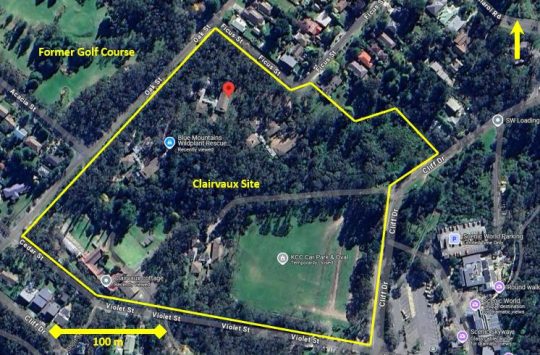
Clairvaux Children’s Home had been established at this site outside Katoomba NSW by the then NSW Government’s Child Welfare Department in 1969. At the time, other state institutions like Mittagong, Brush Farm and Werrington Park were becoming overcrowded, so Clairvaux was opened (outside remote Katoomba) to house another 24 ‘wards of the state‘.
In the beginning, the Home provided accommodation for boys who were described as having “intellectual disabilities”. However, over the years, regrettably paedophilia rape stories emerged about the boys’ mistreatment and horrific sexual abuse. Clairvaux Children’s Home had been allowed by the NSW Government to become an “offending institution”…
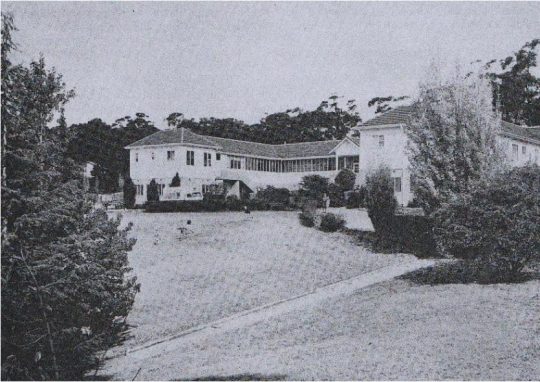
Clairvaux Children’s Home in 1969
“Clairvaux Childrens Home was ultimately closed in 1990, remembered only by the boys (now men) who lived there. In 2014, the grand old building was repurposed into the Clairvaux Community Centre and now serves as the operations centre for a wide range of community-based charities.”
[SOURCE: ‘Offending Institution: Clairvaux Children’s Home’, ^https://kelsolawyers.com/au/institutions/clairvaux-childrens-home/]
We reproduce the published article of Kelso Lawyers herewith:
“Offending Institution: Clairvaux Children’s Home”
SOURCE: ^https://kelsolawyers.com/au/institutions/clairvaux-childrens-home/
“Clairvaux Children’s Home was established at Katoomba NSW by the Child Welfare Department in 1969. At the time, other state institutions like Mittagong, Brush Farm and Werrington Park were becoming overcrowded, so Clairvaux was opened to house another 24 wards of the state.
In the beginning, the Home provided accommodation for boys who were described as having intellectual disabilities.
Clairvaux was closed in 1990, remembered only by the boys (now men) who lived there. In 2014, the grand old building was repurposed into the Clairvaux Community Centre and now serves as the operations centre for a wide range of community-based charities.
But what happened behind closed doors between 1969 and 1990 was disturbing, to say the least — but you won’t hear about it in the news. The boys’ complaints were brushed off by their houseparents and other members of staff on-site.
As wards of the state, they had nowhere else to turn. They lived out of sight of the community. They didn’t have a voice.
In this article, we share the story of one individual who suffered at the hands of a cleaner who worked at Clairvaux.
Active paedophiles roamed the grounds
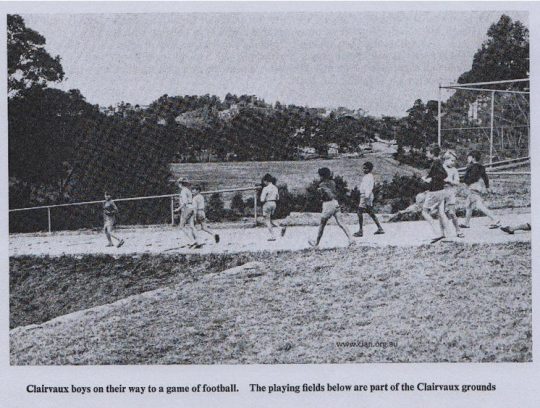
Image: Care Leavers Association
A former resident of Clairvaux (who remains unnamed for privacy) was only six-years-old when he arrived at Clairvaux as a state ward. For the next 10 years, he was sexually abused weekly by a cleaner named “Darryl” who the victim remembered had red hair — a recognisable, memorable feature.
The victim was often sexually abused in Darryl’s work shed, located near the Home’s pool.
Darryl subjected the child to anal penetration every single time.
Believing that someone would help him or at least send Darryl away, the victim told his houseparents, Mr and Mrs Brady, about what was happening to him. Rather than reporting Darryl to the police, they ignored the complaints and the cleaner continued to work there… and continued to abuse the vulnerable child.
The victim then tried to report the abuse to the woman who cooked in the kitchen. She at least sent the child to be checked over by the nurse but again, nothing was done to help him.
With nowhere left to turn, the victim ran away many times but was caught every time.
Eventually, the Department removed him from Clairvaux and sent him to Reiby Youth Justice Centre, followed by Mt Penang Training School. This was a common practice for boys who were considered “difficult to manage”.
Reiby and Mt Penang are known for their harsh discipline and rampant sexual abuse. For this particular victim, moving to Reiby and Mt Penang was not a “light at the end of the tunnel”. Safety was not a luxury enjoyed by the boys who lived there.
If you were abused at Clairvaux, we want to hear your story
So little information is known about Clairvaux and the boys who lived there. Their stories have been lost in time — many are too scared to come forward and tell their stories. This is not uncommon; around 60% of survivors never disclose their experiences with abuse. Many are ashamed and fear they will not be believed.
There are many grown men who still haven’t spoken about their abuse by Darryl the red-haired cleaner, other on-site staff or by their own houseparents.
At Kelso Lawyers, we want to hear your story. Our specialist lawyers have helped hundreds of survivors achieve compensation across Australia. We will lend a sympathetic ear and most importantly, we will believe every word you say.
From here, we will make the compensation application process as simple and stress-free as possible. It is our goal to ensure you achieve the best possible outcome and achieve your own personal breakthrough.”
The home buildings have been abandoned ever since. They are situated off Cedar Street, at a quite separate location to the Wildplant Rescue nursery which is accessed off Hall Street over 250m around the corner.
Blue Mountains Wildplant Rescue Service is wholly a community service. It is the first of its kind in Australia, conceived and founded by local Blackheath village residents Mikla Lewis and Naturalist Wyn Jones in January 1993 to be a community driven, not-for-profit organisation, based in the Blue Mountains of New South Wales to help protect and promote the natural values of the Blue Mountains. It operates to rescue and re-home wild native plants, and to propagate these in its substantial dedicated in order to supply a range of locally endemic plants to local community bushcare groups, landscapers and to the local Blue Mountains Council for ongoing native habitat rehabilitation projects.
Copy on an early newsletter to members ‘Wildplant Press:
 Loading...
Loading...
The Blue Mountains region, despite being mostly world heritage listed in 2000 continues to come under housing land use development pressures from hundreds of building permits issued every year, with most of the development affecting unspoiled native vegetation.
“Block by block, the bushland nature of the Blue Mountains urban area was being slowly but steadily lost, replaced by exotic gardens which deprive native wildlife of food and habit and create huge weed problems in surrounding bushland and National Park. As the group evolved, the original idea of rescuing native plants developed into a bigger plan. The group became aware of the importance of protecting wildplant and wildlife communities in the Blue Mountains on a broader scale than solely rescuing condemned wildplants. The collection of seeds and cuttings for propagation and on-selling to the local community was added to the concept. The facilities at Mount Tomah Botanic Garden were used for propagation of rescued seeds and cuttings, which were then cared for by group members in their own gardens.”
[SOURCE: ^https://www.wildplantrescue.org.au/about]
Indeed, the website of Blue Mountains Wildplant Rescue Service was made possible by the Federal Government’s Stronger Communities Grant.
As well as engaging dozens of local community volunteers, the nursery also employs disabled young people as well as youth offenders undergoing rehabilitation and community re-adjustment through various governmental programmes. These would all cease if the DCJ bean counters get their way.
So what the hell is the Minns Department of Communities and Justice (DCJ) thinking by destroying a community project – seriously?
DCJ’s website motto: “We work with children, young people, adults, families and communities to support vibrant, sustainable and inclusive communities.”
Is this seriously hypocritical or what? DCJ’s threat to shut down this community nursery.
What a hotch-potch of disconnected public service functions the DCJ is! It combines a legal justice type portfolio with community services. Cop this disparate mixed bag of its portfolios in DCJ’s Executive Structure:
- Social Housing
- Disaster Welfare
- Courts and Tribunals
- Victims Services
- Child Protection
- Disability
- Seniors
- Women’s Safety
- Youth Justice
- High Cost Emergency Arrangements
- Law Reform
- Volunteering
- Sentencing
- Disease Testing
- Jury Service
- Domestic Violence
- Anti-Discrimination
- Custodial Services (Prisons)
- Legal Services
- Public Defenders Office
- Solicitor General
- Aboriginal Outcomes
- IT Services
- Financial Performance and Transformation
- Compliance
- Anti-Slavery
- Infrastructure and Assets
It’s a miscellaneous bucket list, and may as well be badged ‘Other’.
The last one here is managed by Katherine Tollner. She’d be the one going after WildPlant Rescue in cahoots with Financial Performance and Transformation’s Bronwyn Roy and Social Housing’s (Homes NSW) Rebecca Pinkstone. And how is Wildplant Rescue not recognised given that DCJ has a Volunteering programme?
Combined, DCJ’s has a bloated army of staff currently numbering 24,000 with a annual spend of $17 billion according to its 2024 annual report! That is 13% of the NSW Government’s annual spend of $130 billion according to the Audit Office of New South Wales website. It spends more than it earns. Its accumulated debt is $137 billion, with official forecast annual interest payments on debt to be (conservatively) $8.6 billion for 2027-28. So, Macquarie Street under the Liberal-National Coalition or Labor/Greens spends half of DCJ’s budget on interest repayments.
Well, Macquarie Street knows how to spend taxpayers’ money like proverbial drunken sailors. It has programme sub-departments to conjure up new programmes to ensure it spends all it gets annually, so its budget doesn’t fall in subsequent years. [NOTE: One is familiar with the NSW governmental bureaucracy, having contracted as a management accountant for multiple NSW Government departments for over a decade].
In the case of the building that houses Wildplant Rescue’s administrative office and other separate outbuildings on the old Clairvaux site, the DCJ has neglected building maintenance and proper upkeep for many decades.
DCJ’s current so-called Executive Director for its Infrastructure and Assets portfolio since Sep 2019 (less lockdowns), Katherine Tollner, has three months governmental experience in a property portfolio as Executive Director Property, Fleet & Procurement at NSW Department of Planning, Housing and Infrastructure (Jul 2019 – Sep 2019).
The NSW Minns Labor Ministry includes this Department Communities and Justice, so-called (DCJ). But under Premier Minns, it is a mish mash mega department of unrelated portfolios as follows:
- Attorney General: The Hon. Michael Daley SC, MP
- Minister for Families and Communities, Minister for Disability Inclusion: The Hon. Kate Washington MP
- Minister for Youth Justice: The Hon. Jihad Dib MP
- Minister for Corrections: The Hon. Anoulack Chanthivong MP
- Minister for Housing, Minister for Homelessness, Minister for Youth: The Hon. Rose Jackson MP
- Minister for Veterans: The Hon. David Harris MP
- Minister for Seniors, Minister for the Prevention of Domestic Violence and Sexual Assault: The Hon. Jodie Harrison MP
So not one minister is accountable. Which one is in charge of the eviction threat? This mega department is supposed to be about ‘communities’ as its name suggests.
The three non-government organisations that are the tenants at the Clairvaux Community Centre are:
- Blue Mountains Wildplant Rescue Service, the native plant nursery
- The Blue Mountains Aboriginal Culture and Resource Centre (ACRC), which has been at Clairvaux for 27 years and claims “to provide crucial support services to the local First Nations community”
- Leura Day Options, a disability support service provided by Greystanes Disability Service
These are each COMMUNITY based services. Hello!
It’s website About Us page reads:
“We work with children, young people, adults, families and communities to support vibrant, sustainable and inclusive communities.”
“DCJ is the lead agency in the Communities and Justice portfolio, which aims to create safe, just, inclusive and resilient communities through its services. DCJ enables services to work together to support everyone’s right to access justice and other help for families, and strengthen the promotion of early intervention and inclusion, with benefits for the whole community. Our purpose is to help create a safe, just, resilient and inclusive NSW in which everyone has the opportunity to realise their potential.”
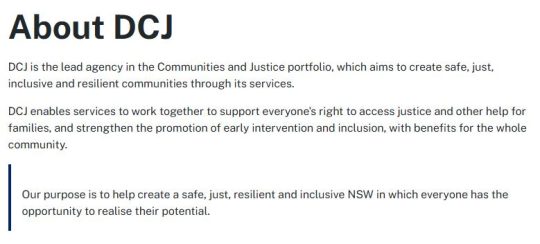

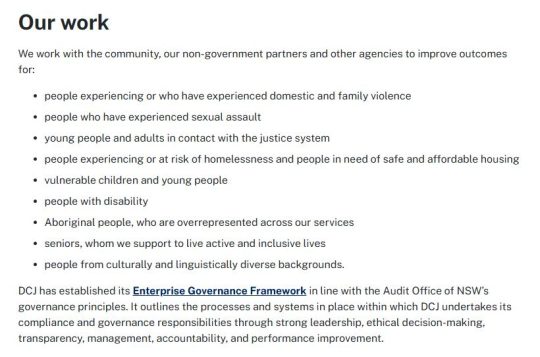
SOURCE: ^https://dcj.nsw.gov.au/about-us/who-we-are-and-what-we-do/about-dcj.html
At Clairvaux COMMUNITY Centre, the tenants facing eviction are a COMMUNITY nursery, an Aboriginal COMMUNITY centre and a disability support centre for disabled members of the local COMMUNITY.
What hypocrisy! The DCJ is also supposed to be about justice, as the name suggest – but it seems it’s more like ‘injustice’.
Council’s Centre for “Planetary Health” – seriously again?
In 2022, Blue Mountains councillors voted unanimously to oppose the eviction of the community groups that use Clairvaux by the DCJ! The mayor will support Trish Doyle’s appeal to the Minister to reconsider.
That same year, the Blue Mountains Council purchased the adjacent defunct Katoomba Golf Clubhouse situated on 30 hectares of public land (long controlled by Council), Council decided to re-branded it a ‘Centre for Planetary Health‘…whatever that means.

We point out that Blue Mountains Council had over previous decades, owned the public land of the Katoomba Golf Course, in its entrusted capacity as a custodian on behalf of the citizens of the Blue Mountains local government area it represents in trust. But the various golf course club operators had gone bankrupt and ‘sympathetically connected’ councillors had bailed them out using ratepayer funds. Say no more.
During the time of 2022, as part of Council’s community consultation outreach invitation, Steven responded to Council in writing proposing that a small portion (1/2 hectare) of the old golf course site be considered by Council allocated to Wildplant Rescue’s nursery, given the imminent threat of the nursery’s eviction from its current site. The current nursery site directly across the street from the old golf course at 14 Oak Street covers about that size.
This relocation literally just across the street, would be the most convenient option for Wildplant Rescue out of other flagged site options considered, if eviction became imminent and unavoidable. Other considered options had been Planet Ark’s former site in Wentworth Falls (north side) off 321 Blaxland Road and the original proposed site for the nursery at the old and disused Blackheath Tip (2 hectare) site off Ridgewell Road, situated about 600 metres along the road from the Great Western Highway, just east of the locked road gate for the Hanging Rock Parking Area. See map below.

Blackheath’s former tip site, contaminated with asbestos and still abandoned by Blue Mountains (city) Council
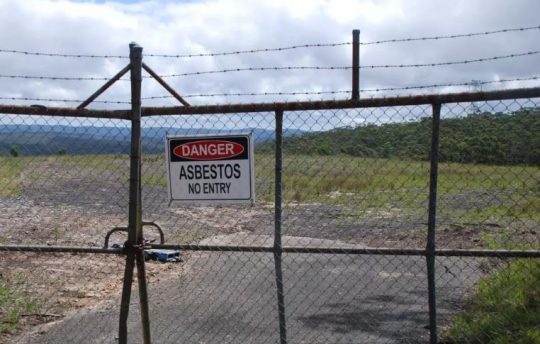
Blue Mountains Council’s old Blackheath Tip site along Ridgewells Road
Recall the lead newspaper article above:
‘The group had talks with council about a possible site during the planning of the old Katoomba golf course precinct. But a spokeswoman for council said:
“a plant nursery is not a permissible use on this site under the current zoning, and an amendment to the LEP would be required to include this and other additional uses. That would be a lengthy process including making a submission to the state government and further public consultation.”….

In 2022, Blue Mountains City Council has voiced its concern over the threat of eviction for three community non-governmental organisations (NGOs) from the Clairvaux Centre in Katoomba.
At the council meeting of February 22, Labor mayor Mark Greenhill introduced a minute that detailed how the Department of Communities and Justice (DCJ) intends to end the lease of the Clairvaux Centre-based NGOs because of renovation costs.
“We need to stand up for those affected NGOS, they operate significant community support services to the Blue Mountains,” said Cr Greenhill. “When I heard about this I was horrified.”
Ward 1 Labor councillor, Suzie van Opdorp, who has an association with the Clairvaux Centre that extends back to the 1980s, also voiced her concerns over the eviction threat.
“These groups are feeling very anxious about their future,” she said. “As anyone would know who has lived and worked in the Mountains, there’s a scarcity of affordable office space for community organisations … These groups are really going to struggle if they’re put out to the open market to look for accommodation – some of them may not survive. It’s clear the facility is worth a lot of money. Our state government has gone about selling lots of publicly owned assets, and I can imagine it would be very tempting to sell this off.”
Ward 2 Greens councillor Brent Hoare and Ward 1 Greens councillor Sarah Redshaw also expressed their disappointment with the proposed eviction, Cr Hoare accusing the state government of “demolition by neglect”.
Blue Mountains City Council (BMCC) have finally answered our questions regarding our suggested involvement in the Planetary Health Initiative on the old Katoomba Golf Course.
BMCC have now clearly stated that this is not a viable option for us because of zoning and other issues which would take years of process to remedy, if at all. They have also confirmed they have no other suitable site available within their portfolio to which the nursery could be relocated. Despite expressing their concern and saying they really value our contribution to the community, they say they can do nothing more to help us.
Yet local Blue Mountains Council has its new ‘Centre for Planetary Health‘ notion situated immediately across the road from Wildplant Rescue’s current site!
This relocation option beckons – more anon.
References:
[1] ‘
Eviction looming‘, 20250115, Blue Mountains Gazette newspaper, p.1, ^
https://www.bluemountainsgazette.com.au/story/8863682/wildplant-nursery-in-katoomba-faces-uncertain-future/?msg=login
[2] ‘
Eviction Update‘, Blue Mountains Wildplant Rescue (website), ^
https://www.wildplantrescue.org.au/blog/eviction-update
[3] ‘
NGOs may have to leave Clairvaux Centre due to renovation costs‘, 2022-03-18, by A.B.M. Smith, ^
https://www.bluemountainsgazette.com.au/story/7651440/clairvaux-eviction-threat/
[4] ‘
Plans still afoot to fix Blackheath tip‘, 2021-07-27, by Jennie Curtin, Blue Mountains Gazette newspaper, ^
https://www.bluemountainsgazette.com.au/story/7352079/tip-clean-up-still-pending/
[5] ‘
Eviction Threat for Wildplant‘, 2025-01-08, ^
https://www.wildplantrescue.org.au/blog/eviction-threat-for-wildplant
[6] ‘
Landlords face fines for ‘non-genuine’ eviction reasons‘, 2024-07-28, by Jack Gramenz and Callum Godde, Australian Associated Press, ^
https://www.bluemountainsgazette.com.au/story/8709944/landlords-face-fines-for-non-genuine-eviction-reasons/
[7] ‘
Heritage for housing‘, 2021-09-13, Blue Mountains Gazette newspaper, ^
https://www.bluemountainsgazette.com.au/story/7413951/heritage-for-housing/?msg=login
[9] ‘
Offending Institution: Clairvaux Children’s Home‘, Kelso Lawyers website, ^
https://kelsolawyers.com/au/institutions/clairvaux-childrens-home/
[10] ‘
Landmark Win For Renters: NSW Rental Reform Bans No-Grounds Evictions and Caps Rent Increases‘, 2024-10-25, by Christine Lai, CityHub, ^
https://cityhub.com.au/nsw-rental-reform-no-grounds-evictions-capped-rent-increases/
[11] ‘
Changes to rental laws‘, NSW Government (Minns Labor), 2024-10-24, ^
https://www.nsw.gov.au/departments-and-agencies/fair-trading/changes-to-rental-laws
